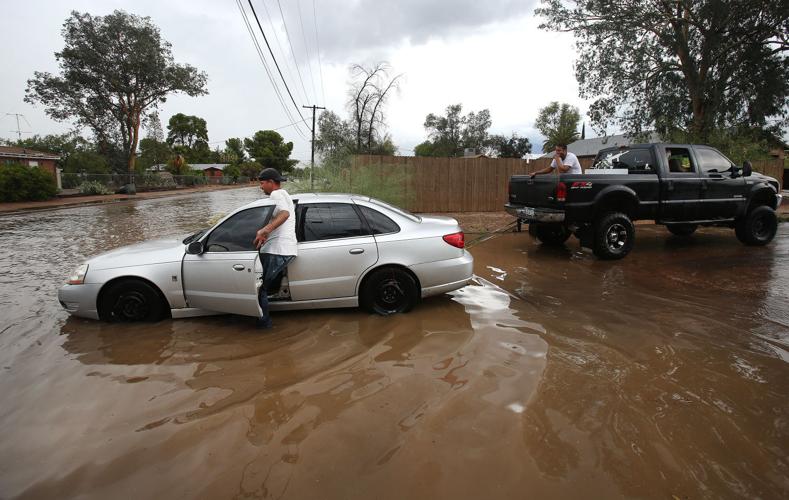June was a month of extremes — extreme heat that killed hikers, followed by extreme storms that knocked down trees and power poles, damaged roofs and flooded streets.
The monthly average temperature of 88.4 is tied for sixth-hottest with 2006. The 115-degree high last month is tied for third-hottest temperature in Tucson with June 25 and 28 in 1994.
The all-time high is 117 on June 26, 1990.
Rainfall was nearly eight times greater than expected.
The extreme events are connected, said Dan Leins, science officer for the National Weather Service in Tucson. It takes heat to lure the rain.
“One part of the monsoon is that moisture gets drawn northward. The primary mechanism is just how hot it gets in the summer.”
If you’ve ever lived near a large body of water, you’ve seen the phenomenon in operation on a daily basis in summer.
Hot days heat the land during the day. The hot air rises, and the cool, moist ocean air surges in the evening, sometimes bringing rain.
The same thing happens on a larger scale during the North American Monsoon. It is so hot, over such large expanses of the Southwest, that moisture rushes in from the south, from the mountains and oceans of Mexico.
“You have that rising hot air and something has to replace it,” Leins said. “But it has to be really hot.”
It was really hot, beginning in early June.
On June 3, it hit 107 in Tucson, followed by 110 and 111.
Then the moisture moved in, temperatures moderated, clouds billowed up over the mountains, and on June 10, the official weather gauge at Tucson International Airport collected 0.2 of an inch of rain. Doesn’t seem like much in most places, but for Tucson in June it equaled the normal total for the month.
Then it dried out — and got even hotter.
On June 18, it was 109 degrees; the next day, 115, followed by 107 and 109.
On Sunday, June 15, when the temperature reached 115 degrees, four hikers died on trails in and around Tucson.
The heat moderated as moisture seeped in, and by the end of that week, storms were showing up south and east of Tucson and in the surrounding mountains.
On Sunday, June 26, the first major thunderstorm of the season blasted Tucson’s midsection.
Towering pine and eucalyptus fell in Winterhaven and Himmel Park as winds gusted to 70 mph and 2 inches of rain dumped in half an hour.
That storm was fairly isolated, but in subsequent days rain fell across Tucson, Southern Arizona and beyond.
“Pretty much the whole state is getting rain,” Leins said on Thursday. Big storms hit from Flagstaff to Nogales and in usually dry regions along the Colorado River and into Southern California, Leins said.
When the final tally came at the end of Thursday, Tucson had received 1.59 inches of June rain, officially. Parts of the region recorded more than 3 inches.
Rainlog’s metro weather map, with more than 200 gauges reported daily by citizen scientists, showed most of Tucson receiving an inch of rain, with 2-inch readings common in midtown and the Catalina Foothills.
Officially, the June 1938 record of 2.07 inches still stands, with June 2016 taking second place.
July continues the soggy saga, with heavy rains falling again Friday.
Things might dry out a bit over the long weekend, Leins said, but it looks like conditions favorable to thunderstorms will return by midweek.
Leins said here is no demonstrated link between an early onset of the monsoon and its productivity.
Tucson receives, on average, 6.08 inches of rain between June 15 and Sept. 30.
In 1938, the record June rain was followed by a mediocre summer and a monsoon rain total of 5.72 inches. In 2000, the third-wettest June on record produced 1.56 inches and a disappointing monsoon total of 4.87 inches.





